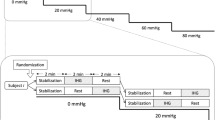Abstract
Blood flow velocities in the middle cerebral artery (MCA) were measured under steady-state and incremental cycle exercises using a transcranial Doppler ultrasound velocimeter. The peak systolic velocity was found to rise markedly under exercise, while the end diastolic velocity tended to remain at the resting value. The relationship between peak systolic velocity and systolic blood pressure, and that between peak systolic velocity and heart rate were found to show a statistically significant correlation. The mean MCA blood velocity also showed a significant correlation with the mean arterial pressure and heart rate. The fluctuations of velocity and the resistance index were calculated in order to evaluate the hemodynamic load on the vessel wall; these also increased markedly under exercise. Such hemodynamic changes in activity might be important in understanding the genesis of vascular diseases, as well as the physiology of cerebral circulation.
Similar content being viewed by others
Explore related subjects
Discover the latest articles, news and stories from top researchers in related subjects.References
von Reuturn G-M, von Buedingn HJ (1993) Ultrasound diagnosis of cerebrovascular disease. Georg-Thieme, Stuttgart, New York
Hennerici MG, Stephen PM (2001) Cerebrovascular ultrasound: theory, practice and future developments. Cambridge University Press, New York
Aaslid R (1987) Visually evoked dynamic blood flow response of the human cerebral circulation. Stroke 18:771–775
Watanabe S, Matsuo T, Sorimachi M, et al (2009) Comparison of blood flow velocity in the middle cerebral artery between men and women at rest and during exercise. Therapeutic Res 30(4):537–544
Ogoh S, Ainslie P (2009) Cerebral blood flow during exercise: mechanism of regulation. J Appl Physiol 107:1370–1380
Guo H, Tierney N, Schaller F, et al (2009) Cerebral autoregulation is preserved during orthostatic stress superimposed with systemic hypotension. J Appl Physiol 100:1785–1792
Aaslid R, Newell D, Stooss R, et al (1991) Assessment of cerebral autoregulation dynamics from simultaneous arterial and venous transcranial Doppler recording in humans. Stroke 22:1148–1154
Pourcelot L (1976) Diagnostic ultrasound for cerebral vascular disease. In: Donald JS, Levi S (eds) Present and future of diagnostic ultrasound. Kooyker, Rotterdam
Author information
Authors and Affiliations
Corresponding author
Additional information
This work was presented in part at the 16th International Symposium on Artificial Life and Robotics, Oita, Japan, January 27–29, 2011
About this article
Cite this article
Matsuo, T., Watanabe, Si., Sorimachi, M. et al. Blood flow velocity waveforms in the middle cerebral artery at rest and during exercise. Artif Life Robotics 16, 398–402 (2011). https://doi.org/10.1007/s10015-011-0960-6
Received:
Accepted:
Published:
Issue Date:
DOI: https://doi.org/10.1007/s10015-011-0960-6




